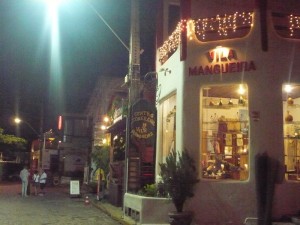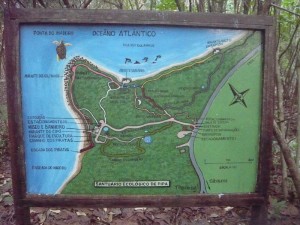 Ainda em março combinamos com minha mãe de comemorarmos meu aniversário em Fernando de Noronha. Nesta época fizemos os cálculos e imaginamos que estaríamos perto de Natal/RN, assim compramos a passagem aérea para Fernando de Noronha saindo de Natal.
Ainda em março combinamos com minha mãe de comemorarmos meu aniversário em Fernando de Noronha. Nesta época fizemos os cálculos e imaginamos que estaríamos perto de Natal/RN, assim compramos a passagem aérea para Fernando de Noronha saindo de Natal.
Back in March we had agreed with my mother to celebrate my birthday in Fernando de Noronha. At that time we thought we would be more or less close to Natal in Rio Grande do Norte (RN), and so we had bought the plane tickets to Fernando de Noronha leaving from there.
Como Pipa/RN fica no caminho entre Tambaba e Natal decidimos aproveitar a ocasião para conhecer este lugar tão afamado. Pipa é considerada a Búzios/RJ do nordeste devido a seus restaurantes sofisticados e lojas de marcas nacionais e internacionais. Sabíamos que Pipa não era o que estávamos procurando, mas como já havíamos encontrado o que buscávamos decidimos conhecer lugares mais turísticos.
Since Pipa (RN) is on the way between Tambaba and Natal, we decided to not let this opportunity pass to get to know such a famous place. Pipa is considered the Búzios (a famous beach town near Rio) of the Northeast because of its sophisticated restaurants and shops selling national and international brands. We knew Pipa was not what we were looking for, but since we had already found our place, we decided to get to know some more touristy places.
 A primeira vista de Pipa foi uma grande surpresa, a paisagem é muito semelhante a Tambaba/Tabatinga: praias entre falésias cobertas por mata. As semelhanças porém acabam por aí. Quando chegamos ao centrinho a diferença entre as duas vilas ficou nítida. A vila de Pipa é ocupada por pessoas de todas as nacionalidades, brasileiros, italianos, espanhóis, portugueses, etc.. É possível adquirir quase tudo que o dinheiro pode comprar (nos compramos novos chinelos) e o clima é de festa e azaração.
A primeira vista de Pipa foi uma grande surpresa, a paisagem é muito semelhante a Tambaba/Tabatinga: praias entre falésias cobertas por mata. As semelhanças porém acabam por aí. Quando chegamos ao centrinho a diferença entre as duas vilas ficou nítida. A vila de Pipa é ocupada por pessoas de todas as nacionalidades, brasileiros, italianos, espanhóis, portugueses, etc.. É possível adquirir quase tudo que o dinheiro pode comprar (nos compramos novos chinelos) e o clima é de festa e azaração.
The first views of Pipa were a great surprise. The landscape is very similar to Tambaba/Tabatinga: beaches between cliffs covered with forest. But the similarities ended there. As we approached the town the difference between the two villages became clear. The center of Pipa is full of people of all nationalities: Brazilians, Italians, Spanish, Portuguese, …. In Pipa you can buy almost anything (we got ourselves some new flip flops) and the spirit is one of party and flirts.
Como de praxe, caminhamos para todos os lados. Fomos andando até o Chapadão, passando pela Praia Principal, a Praia do Amor e das Minas. Também nos encantamos pelo outro lado do litoral, a Baia dos Golfinho e a Praia do Madeiro. Pipa é um daqueles lugares que mudou muito depois que o turismo chegou, e continua sofrendo uma grande pressão da indústria imobiliária e hoteleira. Contudo, nesta selva de ocupação algumas imagens permanecem salvaguardadas e cenário é lindíssimo.
As always, we discovered everything by foot. We walked to the Chapadao, passing the main beach, the Amor beach, and Minas beach. We also enjoyed the other side of the coast, the Bay of the Dolphins, and the Madeiro beach. Pipa is one of these places that changed a lot when tourism arrived and continues to suffer from the big pressure of the real estate and hotel industries. Yet, in the midst of this construction wilderness some images have been saved and the scenery is amazing.
 Este é o caso das falésias da Praia do Madeiro e da Baia do Golfinho que ainda estão encoberta por um pouco da Mata Atlântica. Uma das razões para tanto é o Santuário Ecológico de Pipa. Uma área de aproximadamente 90 hectares no topo da Praia do Madeiro. Visitamos o Santuário, vimos tartarugas marinhas imensas lá de cima e apreendemos um pouco sobre a Mata Atlântica do nordeste do Brasil. Ficamos curiosos e marcamos um encontro com David Hasset, o proprietário do Santuário para conhecer mais sobre o projeto. Infelizmente ele não estava em Pipa, então vamos conhecê-lo na volta de Fernando de Noronha e contaremos tudo a vocês!
Este é o caso das falésias da Praia do Madeiro e da Baia do Golfinho que ainda estão encoberta por um pouco da Mata Atlântica. Uma das razões para tanto é o Santuário Ecológico de Pipa. Uma área de aproximadamente 90 hectares no topo da Praia do Madeiro. Visitamos o Santuário, vimos tartarugas marinhas imensas lá de cima e apreendemos um pouco sobre a Mata Atlântica do nordeste do Brasil. Ficamos curiosos e marcamos um encontro com David Hasset, o proprietário do Santuário para conhecer mais sobre o projeto. Infelizmente ele não estava em Pipa, então vamos conhecê-lo na volta de Fernando de Noronha e contaremos tudo a vocês!
This is the case of the Madeiro beach and the Bay of Dolphins, which are still covered by some Atlantic forest. One of the reasons for this is the Ecological Sanctuary of Pipa, an area of roughly 90 hectares on top of the Madeiro beach. We visited the sanctuary, saw enormous sea turtles from up there and learned a bit about the Atlantic Forest of Northeast Brazil. We became curious and made an appointment with David Hasset, the owner of the Sanctuary to get to know more about the project. Unfortunately, he was not in Pipa and so we will meet him when we come back from Fernando de Noronha!
